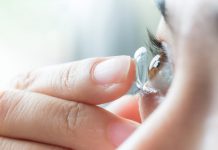Aloe Vera is a great antioxidant, protecting the skin from oxidative damages caused by the sun, thus encouraging a radiant and natural glow. Its antibacterial properties help to treat pimples and acne, giving a smooth skin texture. In addition, aloe vera can help with skin lightening and doing away with blemishes and dark spots, effectively de-pigmenting your skin.
The clear gel-like substance inside the leaves of the plant, popularly known as Aloe Vera gel contains 75 potentially active constituents – vitamins, enzymes, minerals, sugars, lignin, saponins, salicylic acids, and amino acids.
This DIY face pack helps in turning your dry and dull skin to a plump and supple one. This aloe vera face pack is recommended for all skin types.
Supplies:
- 2 aloe vera leaves (fresh is better, but if you don’t have an aloe plant, I recommend using this gel)
- Juice from ½ a lemon
- 1 tablespoon raw honey
- Blender
- Knife
- Thin cloth (optional)
Instructions:
Step 1:
Cut two aloe vera leaves from the base of the plant. Slice the edges (pointy teeth) lengthwise from each side of the leaf in long sections. Then chop the leaf into two- to three-inch sections. This will make getting to the gel much easier than slicing an entire leaf whole.
Step 2:
Once you’ve exposed the aloe vera gel, use a knife to extract the gel from the leaf sections. It’s okay if you’ve got some pulp along with the gel. Place the gel (and any attached pulp) in a blender along with the honey and lemon juice. Blend for 30–60 seconds.
Step 3:
How watery your aloe vera face pack is will depend on the size of your lemon and the consistency of your aloe vera gel. You can apply the mixture directly onto your face and neck (avoid the eye area since that is more sensitive) for 10–15 minutes.
Alternatively, you can dip a thin cloth into the mixture, soak it well, and lay it over your face and neck to make a sheet mask. Store any leftovers in the refrigerator for up to 24 hours.
Face Pack Tips:
Place dry cotton pads over your eyes underneath the cloth if you are worried about irritating the skin in the eye area.
If you feel any type of mild stinging, don’t be alarmed; you might just need to dilute the lemon juice with water a little. If you develop a rash or persistent irritation and/or burning, rinse off your face with water and contact your dermatologist.
Once you are finished, wash off with warm water and follow with a moisturizer.
This mask can be done once a month as a brightening and firming pack.
As with any time you are using an exfoliant, either store-bought or homemade, you will want to be sure you use an appropriate SPF for sun protection afterward. This is because your skin will be more susceptible to sunburn and sun damage directly following an exfoliating treatment.
Contact with citric acids, such as lemon juice, may make the skin more sensitive to burns upon exposure to sunlight and may cause rashes and dark hyperpigmentation. So cover up!
You don’t want to undo all that work of revealing fresh, glowing skin by being in the sun unprotected. Sunscreen with an SPF of 30 or above and sun-protective clothing are ways to protect your skin from not only sunburns but also those cosmetically displeasing pigmented sun spots.



























